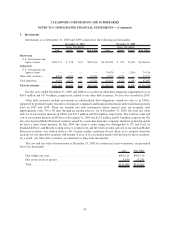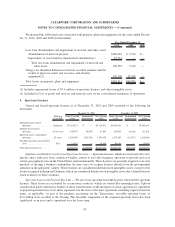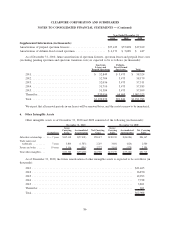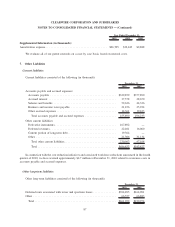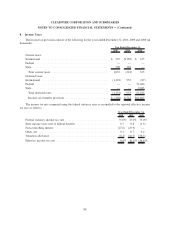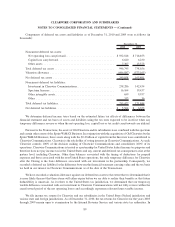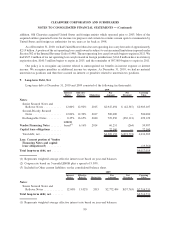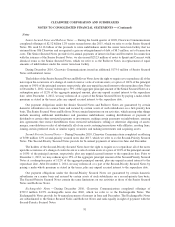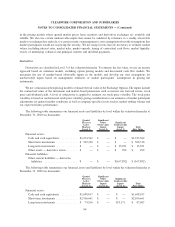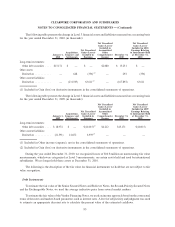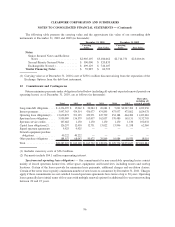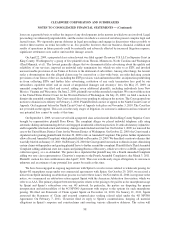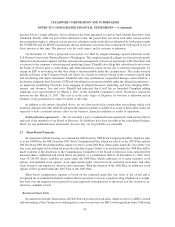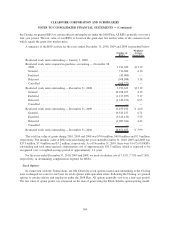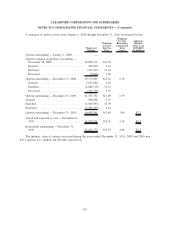Clearwire 2010 Annual Report Download - page 98
Download and view the complete annual report
Please find page 98 of the 2010 Clearwire annual report below. You can navigate through the pages in the report by either clicking on the pages listed below, or by using the keyword search tool below to find specific information within the annual report.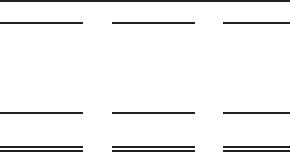
Interest Expense — Interest expense included in our consolidated statements of operations for the years ended
December 31, 2010, 2009 and 2008, consisted of the following (in thousands):
2010 2009 2008
Year Ended December 31,
Interest coupon ........................................... $346,984 $ 145,453 $19,347
Accretion of debt discount and amortization of debt premium, net ...... 14,479 64,183 1,667
Capitalized interest......................................... (208,595) (140,168) (4,469)
$ 152,868 $ 69,468 $16,545
10. Derivative Instruments
The holders’ exchange rights contained in the Exchangeable Notes issued in December 2010 constitute
embedded derivative instruments that are required to be accounted for separately from the debt host instrument at
fair value. As a result, upon the issuance of the Exchangeable Notes, we recognized exchange options, which we
refer to as Exchange Options, with an estimated fair value of $231.5 million as a derivative liability. The Exchange
Options are indexed to Class A Common Stock, have a notional amount of 103.0 million shares and mature in 2040.
We do not apply hedge accounting to the Exchange Options. Therefore, gains and losses due to changes in fair value
are reported in our consolidated statements of operations. At December 31, 2010, the Exchange Options’ estimated
fair value of $167.9 million was reported in other current liabilities on our consolidated balance sheet. For the year
ended December 31, 2010, we recognized a gain of $63.6 million from the changes in the estimated fair value since
inception in gain (loss) on derivative instruments in our consolidated statements of operations. See Note 11, Fair
Value, for information regarding valuation of the Exchange Options.
During 2009, we had two interest rate swap contracts which were based on 3-month LIBOR with a combined
notional of $600.0 million. We used these swaps as economic hedges of the interest rate risk related to a portion of
our long-term debt. The interest rate swaps were used to reduce the variability of future interest payments on our
LIBOR based debt. We were not holding these interest rate swap contracts for trading or speculative purposes. We
did not apply hedge accounting to these swaps, therefore the gains and losses due to changes in fair value were
reported in other income (expense), net in our consolidated statements of operations.
For the year ended December 31, 2009, we recognized a net loss of $7.0 million on undesignated swap
contracts. During the fourth quarter of 2009, we terminated the swap contracts and paid the swap counterparties
$18.4 million which consisted of $14.7 million mark to market losses and $3.7 million accrued interest.
11. Fair Value
The following is a description of the valuation methodologies and pricing assumptions we used for financial
instruments measured and recorded at fair value on a recurring basis in our financial statements and the
classification of such instruments pursuant to the valuation hierarchy.
Cash Equivalents and Investments
Where quoted prices for identical securities are available in an active market, we use quoted market prices to
determine the fair value of investment securities and cash equivalents, and they are classified in Level 1 of the
valuation hierarchy. Level 1 securities include U.S. Government and Agency Issues and money market mutual
funds for which there are quoted prices in active markets.
For other debt securities which are classified in Level 3, we use discounted cash flow models to estimate the
fair value using various methods including the market and income approaches. In developing these models, we
utilize certain assumptions that market participants would use in pricing the investment, including assumptions
about risk and the risks inherent in the inputs to the valuation technique. We maximize the use of observable inputs
93
CLEARWIRE CORPORATION AND SUBSIDIARIES
NOTES TO CONSOLIDATED FINANCIAL STATEMENTS — (Continued)


